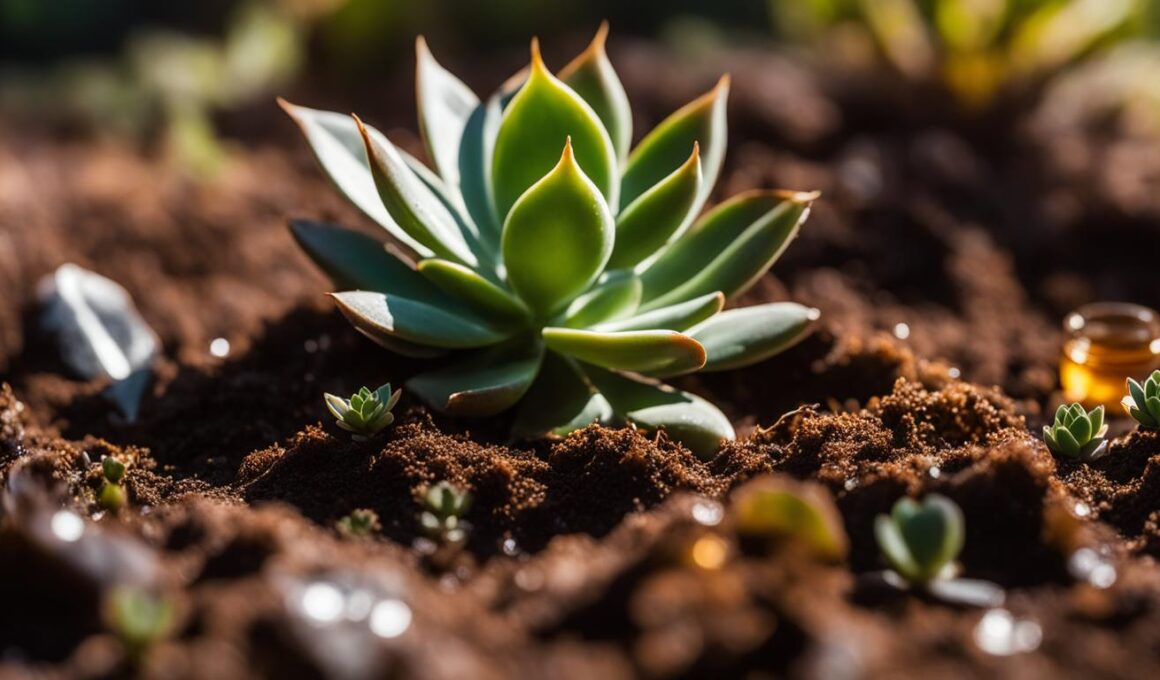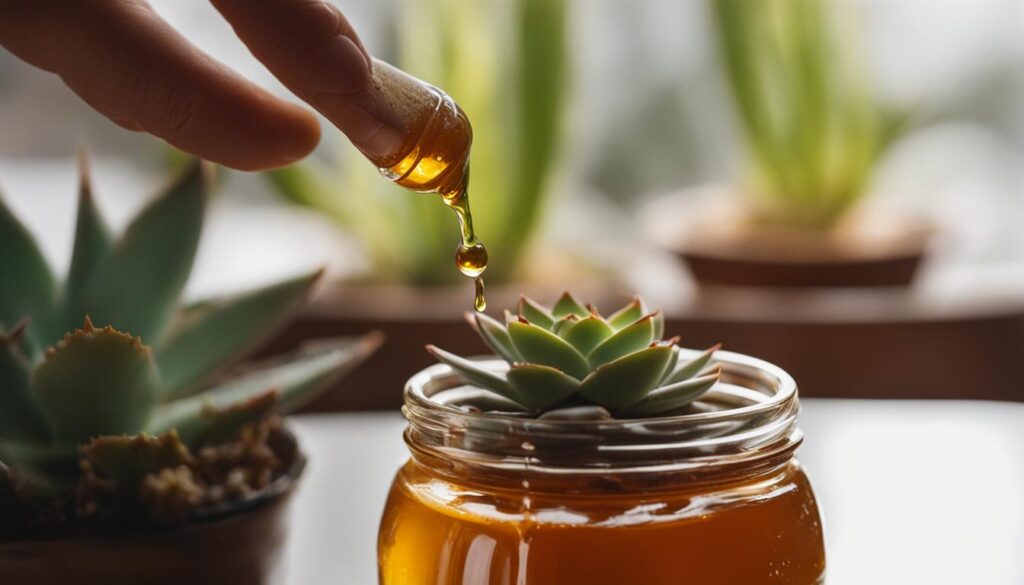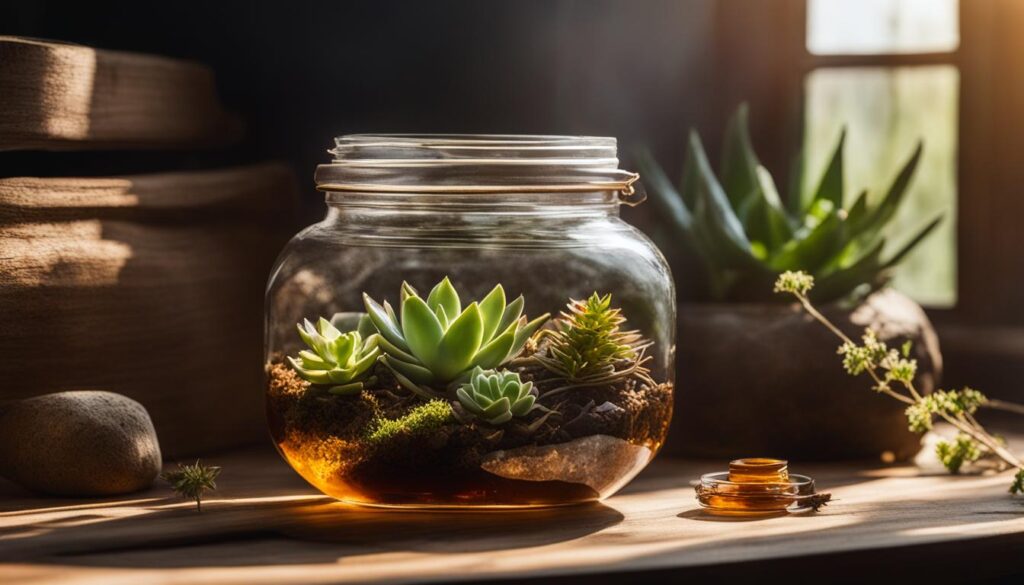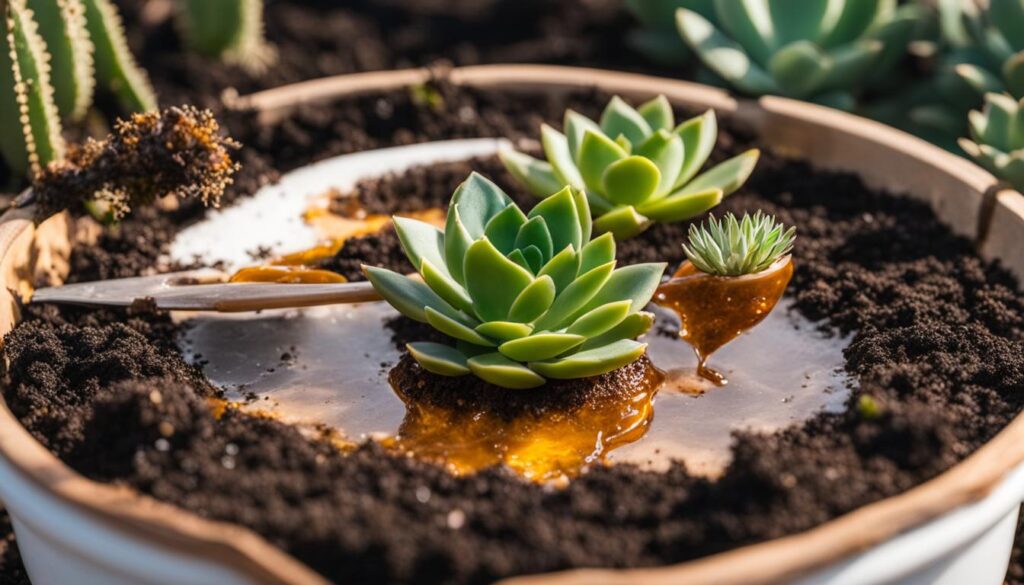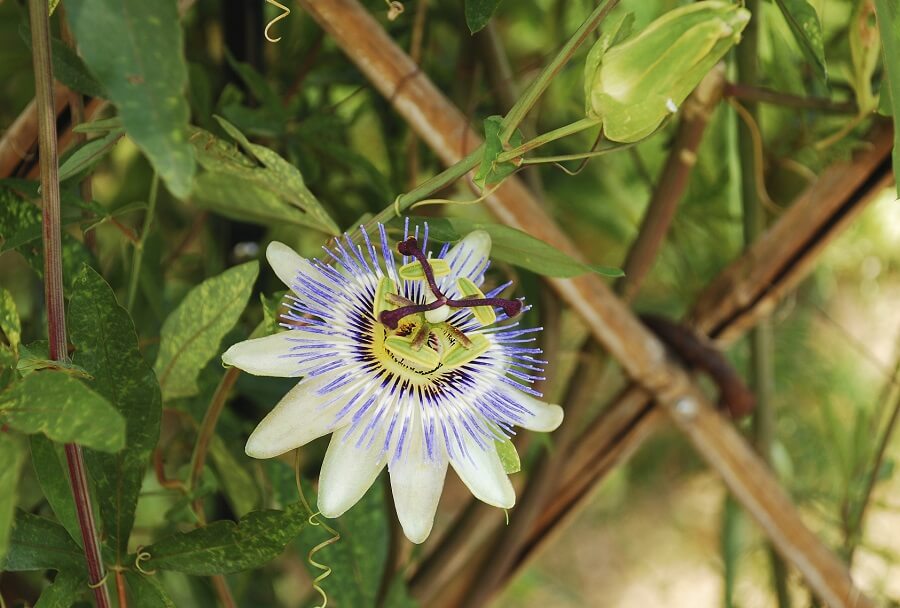Are you looking for a natural way to propagate your succulents? Look no further than honey! Honey contains antiseptic and anti-fungal properties that can aid in the successful propagation of succulents. Many growers have observed success using honey as a rooting aid, promoting root and leaf growth. In this article, we will explore the benefits of using honey as a natural rooting hormone and provide you with step-by-step instructions on how to propagate succulents with honey.
Post Summary
- Honey contains antiseptic and anti-fungal properties that can help prevent bacterial and fungal infections during succulent propagation.
- Using honey as a rooting hormone is an organic, inexpensive, and readily available option compared to synthetic rooting hormones.
- To use honey as a rooting hormone, dilute two tablespoons of pure honey in a cup of warm water or directly dip succulent leaves or stems into plain honey.
- Allow succulent cuttings to dry out for about 3 to 4 weeks until callus formation occurs before applying honey as a rooting hormone.
- After applying honey, place the cuttings on top of moist, gritty soil and mist lightly every two days, avoiding overwatering.
The Benefits of Natural Rooting Hormones
Natural rooting hormones, such as honey, offer several benefits for succulent propagation. They are organic, inexpensive, and readily available. Unlike synthetic rooting hormones, they do not pose health risks or harm to the environment. Natural rooting hormones can help stimulate root development, protect cuttings from fungal issues, and improve the success rate of propagating succulents.
Using natural rooting hormones like honey provides a safe and effective way to promote the growth of succulent cuttings. Honey contains antiseptic and anti-fungal properties that can help prevent bacterial and fungal infections during the propagation process. These natural properties help create a favorable environment for root and leaf growth, increasing the chances of successful propagation.
“Natural rooting hormones, such as honey, offer several benefits for succulent propagation. They are organic, inexpensive, and readily available.”
Furthermore, natural rooting hormones like honey are easily accessible and cost-effective. Honey can be found in most households and does not require any additional purchases. This makes it a convenient option for succulent growers who want to use natural methods for propagation without spending a fortune on synthetic rooting hormones.
In summary, the benefits of natural rooting hormones, such as honey, cannot be understated. They are organic, safe, and readily available, making them a popular choice among succulent enthusiasts. By using natural rooting hormones, growers can stimulate root development, protect cuttings from fungal issues, and increase the success rate of propagating succulents.
Benefits of Using Honey as a Rooting Hormone
Using honey as a rooting hormone offers several benefits for succulent propagation. Unlike synthetic rooting hormones, honey is organic, inexpensive, and readily available. It’s a natural alternative that can stimulate root development, protect cuttings from fungal issues, and improve the success rate of propagating succulents. Additionally, honey’s antiseptic and anti-fungal properties make it a safe and effective option for those who prefer natural methods of plant propagation.
| Benefits of Using Honey as a Rooting Hormone |
|---|
| Organic and environmentally friendly |
| Stimulates root development |
| Protects against bacterial and fungal infections |
| Safe and effective alternative to synthetic rooting hormones |
Other Natural Rooting Hormones
While honey is a popular natural rooting hormone for succulent propagation, there are other alternatives that can be used with promising results. One such option is cinnamon powder, which is known for its anti-fungal properties. Applying cinnamon to the ends of stem cuttings can help prevent fungal issues and stimulate root growth. It is a cost-effective and readily available option that can be easily incorporated into your propagation routine. Another natural rooting hormone to consider is apple cider vinegar. When used in moderation, apple cider vinegar can act as a root enhancer, thanks to its beneficial elements that promote plant growth. However, it is crucial to use these natural rooting hormones properly and in the right amounts to avoid any potential negative effects on your plants.
Table:
| Natural Rooting Hormones | Usage and Benefits |
|---|---|
| Cinnamon powder | Anti-fungal properties Stimulates root growth |
| Apple cider vinegar | Acts as a root enhancer Promotes plant growth |
Incorporating these natural rooting hormones into your succulent propagation process can offer additional options for success. Experimenting with different methods and finding what works best for your succulents can be a rewarding journey. It is essential to remember that each succulent species may respond differently to these natural rooting hormones, so it may require some trial and error to achieve the desired results. By combining the benefits of honey, cinnamon, and apple cider vinegar, you can explore a range of natural options to help your succulent cuttings thrive.
How to Prepare Succulents for Propagation with Honey
Before using honey as a rooting hormone for your succulent cuttings, it is crucial to prepare them properly. Whether you are working with leaf or stem cuttings, the initial steps are essential to ensure successful propagation.
If you are propagating from leaf cuttings, gently twist the leaves to remove them from the plant, making sure they come out cleanly from the stem. For stem cuttings, use clean scissors or shears to make a precise cut just above the leaf node. These steps not only promote healing and prevent infections but also provide a clean starting point for root and leaf growth.
After taking your cuttings, allow them to dry out in a well-ventilated area for about three to four weeks until callus formation occurs. Callus formation is the development of a protective tissue layer at the cut end of the cutting, which helps prevent infections and rotting when the cuttings are eventually planted.
| Type of Cutting | Preparation Steps |
|---|---|
| Leaf Cuttings | Gently twist leaves off the stem, ensuring a clean break. |
| Stem Cuttings | Use clean scissors or shears to make a precise cut just above the leaf node. |
By following these preparation steps, you set the stage for successful succulent propagation using honey as a rooting hormone. The healing and callus formation process allows the cuttings to establish a strong foundation for root development and eventual growth as individual plants.
Proper preparation of succulent cuttings is crucial to ensure successful propagation. By gently removing leaves or making clean cuts on stem cuttings, you promote healing and prevent infections. Allowing the cuttings to dry out and form calluses further protects them from rotting and prepares them for the rooting stage.
Applying Honey as a Rooting Hormone
When it comes to propagating succulents, using honey as a rooting hormone can be a natural and effective method. The antiseptic and anti-fungal properties of honey make it a suitable option for encouraging root growth and protecting against bacterial and fungal infections. To apply honey as a rooting hormone, start by diluting two tablespoons of pure honey in a cup of warm water. Alternatively, you can directly dip the end of your dried-out leaf or stem cutting into plain honey before planting it.
Once you have applied honey to your succulent cuttings, it’s important to plant them correctly. Lay the cuttings on top of moist, gritty soil in a tray or pot, making sure not to bury them. Mist the cuttings lightly every two days, but be careful not to overwater. Over time, the roots should start to develop, signaling successful propagation. Patience and consistency in watering and care are crucial to ensure the best results.
Applying Honey as a Rooting Hormone Table
| Succulent Type | Recommended Honey Application Method | Time to Root Development |
|---|---|---|
| Jade Plants | Dip in diluted honey | 7-14 days |
| Echeveria | Dip in plain honey | 7-14 days |
| Kalanchoe | Dip in diluted honey | 7-14 days |
| Sedum | Dip in plain honey | 7-14 days |
| Graptoverias | Dip in diluted honey | 7-14 days |
| Sedum rubrotinctum (“Pork and Beans”) | Dip in plain honey | 7-14 days |
Remember, the success of using honey as a rooting hormone may vary depending on various factors, including the specific succulent species and individual plant conditions. However, applying honey as a rooting hormone can be a natural and cost-effective method to propagate your succulents. Give it a try and see how it works for you!
Why Honey Works as a Rooting Hormone
When it comes to propagating succulents, honey is a natural and effective rooting hormone. But why exactly does honey work so well in promoting root growth? The answer lies in the properties of honey that make it an excellent choice for succulent propagation.
Firstly, honey contains antiseptic properties that help prevent bacterial and fungal infections. This is crucial during the delicate process of root development, as any infections can hinder the growth of new roots. By applying honey to succulent cuttings, you create a protective barrier that defends against harmful microorganisms, allowing the plant to focus on root development.
In addition to its antiseptic properties, honey also has anti-fungal properties. This is important because succulents are susceptible to fungal issues, particularly when their cuttings are exposed to moisture. The anti-fungal properties of honey help shield the cuttings from fungal infections, reducing the risk of rot or other fungal diseases.
“Honey acts as a natural antiseptic and anti-fungal agent, promoting root growth and protection against bacteria and fungi.”
Furthermore, honey contains natural enzymes that can stimulate root growth. These enzymes help trigger the growth process and encourage the formation of new roots. This is especially beneficial for succulent cuttings, as the development of strong roots is essential for their survival and future growth as independent plants.
Overall, the unique properties of honey, including its antiseptic and anti-fungal qualities, as well as its ability to stimulate root growth, make it an effective choice as a rooting hormone for succulent propagation. While synthetic rooting hormones may offer quicker results, honey provides a natural and safer alternative, with a higher success rate in producing healthy and thriving succulent plants.
Post-Propagation Care for Succulent Cuttings
Once your succulent cuttings have started to develop roots, it’s crucial to provide them with proper care to ensure their healthy growth and establishment. Here are some essential post-propagation care tips for your propagated succulent cuttings:
1. Allow for Growth and Development
After your cuttings have developed roots, give them a few weeks to grow and establish themselves. During this period, it’s important to avoid disturbing the plants and allow them to acclimate to their new environment. This will give them the best chance to thrive and flourish.
2. Transplanting and Potting
Once the roots on your propagated succulent cuttings are fully developed, it’s time to transplant them into suitable pots with a well-draining succulent soil mix. Choose a pot that is slightly larger than the root system of the cutting and ensure it has drainage holes to prevent overwatering. Gently remove the old leaf from which the propagation started and plant the clone succulent in the pot, making sure the roots are covered with soil.
3. Gradual Sunlight Exposure
After transplanting, it’s important to acclimate your newly propagated succulents to brighter sunlight gradually. Start by placing them in a shady area for a few days, gradually increasing their exposure to sunlight over time. This will help prevent sunburn and ensure a smooth transition for the plants.
| Post-Propagation Care Tips | Summary |
|---|---|
| Allow for Growth and Development | Give the cuttings time and space to grow and establish themselves before moving them. |
| Transplanting and Potting | Transfer the rooted cuttings into suitable pots with well-draining soil mix and remove the old leaf. |
| Gradual Sunlight Exposure | Acclimate the newly propagated succulents to brighter sunlight gradually to prevent sunburn. |
Following these post-propagation care tips will help ensure the success and long-term health of your propagated succulent cuttings. Remember to be patient and monitor their progress as they continue to grow and thrive in their new homes.
Top Succulents for Propagation with Honey
If you’re looking to propagate your succulents using honey as a rooting hormone, there are certain varieties that have shown particular success with this method. These honey-rooted succulents are known for their resilience, ease of propagation, and attractive appearances. By using honey as a rooting aid, you can enhance root development and increase the chances of successful propagation for these specific succulent species.
Jade Plants
Jade plants (Crassula ovata) are popular succulents known for their fleshy, oval-shaped leaves and tree-like appearance. They are relatively easy to propagate and can be successfully rooted using honey as a rooting hormone. By applying honey to the cut ends of jade plant leaves or stems, you can promote root growth and increase the chances of successful propagation.
Echeveria
Echeveria is a diverse genus of succulents that come in a variety of colors, shapes, and sizes. They are characterized by their rosette-shaped leaves and are highly sought after by succulent enthusiasts. Echeveria can be propagated with honey as a rooting hormone, allowing for the development of strong and healthy roots during the propagation process.
Kalanchoe
Kalanchoe is a genus of flowering succulents that are known for their vibrant blooms and ability to thrive in various conditions. These hardy succulents can be successfully propagated using honey as a rooting hormone. By applying honey to the cut ends of kalanchoe leaves or stems, you can encourage root growth and increase the chances of successful propagation.
Sedum and Graptoverias
Sedum and graptoverias are two closely related genera of succulents that are known for their diverse and colorful foliage. These succulents can be easily propagated using honey as a rooting hormone. Honey helps stimulate root development and provides protection against bacterial and fungal infections, increasing the chances of successful propagation.
Sedum Rubrotinctum (Pork and Beans)
Sedum rubrotinctum, also known as “Pork and Beans” due to its red and green foliage, is a popular succulent for both indoor and outdoor gardens. This succulent can be propagated with honey as a rooting hormone, allowing for the development of strong and healthy roots. By applying honey to the cut ends of Sedum rubrotinctum leaves or stems, you can increase the chances of successful propagation.
In conclusion, while honey can be used as a rooting hormone for various succulents, certain species have shown particular success when propagated with honey. Jade plants, echeveria, kalanchoe, sedum, graptoverias, and Sedum rubrotinctum are among the top succulents suitable for honey as a rooting hormone. By using honey during the propagation process, you can enhance root development and increase the success rate of propagating these specific succulent varieties.
Conclusion
Succulent propagation with honey is a natural and potentially effective method for growing new plants. By using honey as a rooting hormone, you can take advantage of its antiseptic and anti-fungal properties to promote root and leaf growth. Although results may vary, many growers have reported success with this method.
To ensure the best chances of successful propagation, it is important to properly prepare your succulent cuttings. Gently twist the leaves or make clean cuts on stem cuttings, allowing them to dry out in a well-ventilated area until callus formation occurs. Once ready, dip the cuttings in diluted honey or apply plain honey to create a thin layer.
After applying honey, place the cuttings on top of moist, gritty soil and mist them lightly every two days. It is crucial to avoid overwatering to prevent rotting. With patience and proper care, you can expect to see roots develop within a few weeks. Once rooted, carefully transfer the new plants to suitable pots and provide post-propagation care.
Overall, succulent propagation with honey offers a natural and rewarding way to expand your succulent collection. Give it a try and enjoy the process of watching your propagated succulents thrive and grow into beautiful plants.
Is Using Honey for Propagating Succulents More Effective in Warmer Temperatures?
When propagating succulents, using honey in warmer temperatures can be more effective. The natural antibacterial properties of honey can help prevent rot in succulent cuttings, while the warmth can promote root growth. This method can lead to higher success rates when propagating succulents in a warm climate.
FAQ
Can honey be used as a rooting hormone for succulent propagation?
Yes, honey can be used as a natural rooting hormone for propagating succulents. It contains antiseptic and anti-fungal properties that may help prevent bacterial and fungal infections and encourage root and leaf growth.
What type of honey should be used for succulent propagation?
It is important to use pure honey without any added sugar or that has undergone pasteurization. This ensures that the honey retains its beneficial properties and does not harm the succulent cuttings.
How do natural rooting hormones like honey compare to synthetic ones?
Natural rooting hormones, such as honey, are organic, inexpensive, and readily available. Unlike synthetic rooting hormones, they do not pose health risks or harm to the environment. They can stimulate root development, protect cuttings from fungal issues, and improve the success rate of propagating succulents.
How should honey be used as a rooting hormone for succulents?
To use honey as a rooting hormone, it is recommended to dilute two tablespoons of pure honey in a cup of warm water. Alternatively, some growers prefer to directly dip succulent leaves or stems into plain honey before planting them. Honey acts as a natural antiseptic and anti-fungal agent, promoting root growth and protection against bacteria and fungi.
Are there other natural rooting hormones that can be used for succulent propagation?
Yes, cinnamon powder, known for its anti-fungal properties, can be applied to stem ends to prevent fungal issues and stimulate root growth. Apple cider vinegar, when used in moderation, can act as a root enhancer. However, it is important to use natural rooting hormones properly to avoid negative effects on the plants.
How should succulents be prepared for propagation with honey?
When propagating from leaf cuttings, gently twist the leaves to remove them from the plant, ensuring they come out cleanly from the stem. For stem cuttings, use clean scissors or shears to make a clean cut just above the leaf node. After taking cuttings, allow them to dry out in a well-ventilated area for about 3 to 4 weeks until callus formation occurs.
How do you apply honey as a rooting hormone for succulents?
Once the succulent cuttings have calloused, dip the end of the dried-out leaf or stem cutting into honey to create a thin layer. Then, lay the cuttings on top of moist (not wet) gritty soil in a tray or pot. Mist the cuttings lightly every two days, but avoid overwatering. The roots should start to develop within a few weeks if the watering pattern and care are maintained.
Why does honey work as a rooting hormone for succulents?
Honey contains antiseptic and anti-fungal properties that help keep bacteria and fungi at bay, allowing the natural rooting hormones in the plant to function effectively. While synthetic rooting hormones may produce quicker results, honey has a higher success rate in producing roots over time.
What care is required for succulent cuttings after propagation?
After the succulent cuttings have started to develop roots, allow them to grow and develop for a few weeks before moving them. Once the roots are fully developed, remove the old leaf from which the propagation started and plant the clone succulent in a suitable pot with a well-draining succulent soil mix. Keep the newly propagated plants in shade for a few days and gradually acclimate them to brighter sunlight.
Which succulents are suitable for propagation with honey?
Some succulents that have shown success when propagated with honey include jade plants, echeveria, kalanchoe, sedum, graptoverias, and Sedum rubrotinctum (also known as “Pork and Beans”). These succulents are known for their resilience, easy propagation methods, and attractive appearances.





